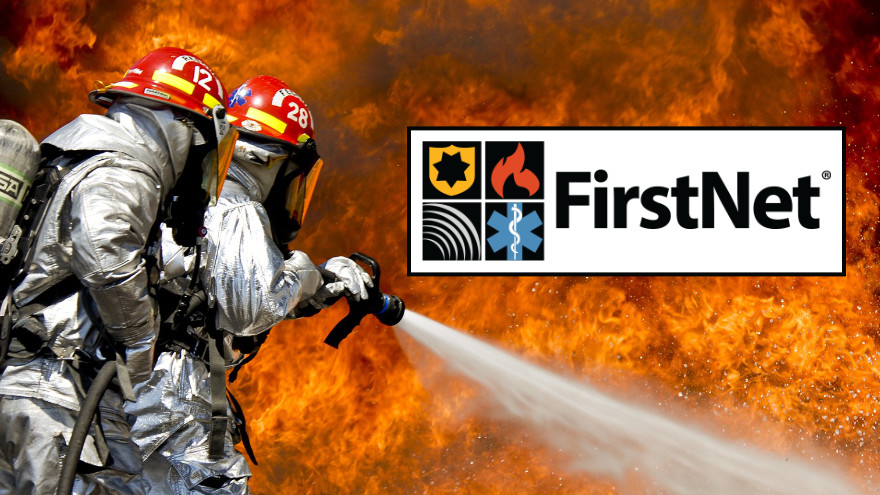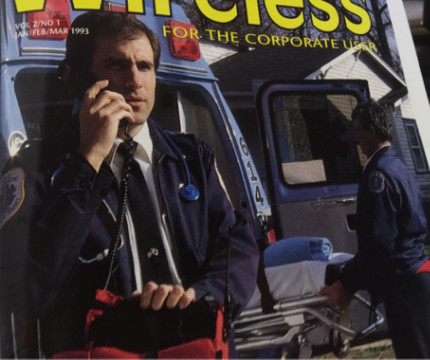
FirstNet is an abbreviation of – First Responder Network Authority, which was established in 2012 pursuant to the Middle Class Tax Relief and Job Recovery Act. Although the primary impetus for FirstNet was the 9/11 2001 terror attacks and the resultant 9/11 Commission report, documenting the severe communications problems of the First Responders, it took until 2012 for a consensus and Act of Congress, authorizing a solution.
And it has taken another five years to get to the point where the FirstNet authority finally selected AT&T to build and manage the network.
The Promise

1993 article highlighted first responder net inadequacy
The problems for First Responders have been obvious for more than two decades. A 1993 story in “Wireless For The Corporate User” magazine highlighted an EMS worker’s plight in being forced to used the public cellular network for medical emergency calls from the field, because the dedicated MEDCOM network was so inadequate.
FirstNet promises to alleviate major problems, the promise being that it will hopefully provide adequate spectrum capability for even serious disasters, give First Responders an assured level of priority on the network and that it will enable all First Responders to use devices that are compatible with each other.
FirstNet’s Deal with AT&T
In March 2017 FirstNet announced that AT&T had been given a “25-year award based on the determination of the overall best value solution for FirstNet and public safety.” The award came as no surprise as all possible competitive bidders had been eliminated in the bidding process.
FirstNet announced that the deal included:
- Award to AT&T of 20 MHz of spectrum and $6.5 billion in initial funding;
- In return, AT&T agrees to deploy and operate the “nationwide high-speed broadband network” for public safety over 25 years;
- An estimate that AT&T would spend about $40 billion over the life of the contract to build, operate, deploy, and maintain the Network, and presumably keep the network up to date;
- When FirstNet’s spectrum is not being used by public safety, AT&T can use it for other, commercial purposes;
- First Responders will be prioritized over commercial users;
- “FirstNet will oversee this contract to ensure it delivers innovation, technology and customer care to public safety through various mechanisms, including subscriber adoption targets, milestone buildouts, disincentive fees and other mechanisms outlined in the contract.”
Some Questions
As far as we could determine, the actual contract has not been publicly filed; we say this because calls to both the Department of Commerce and the FirstNet PR offices were met with the response that they didn’t know if the contract was publicly available.
While FirstNet has been stingy on releasing details of this monumental arrangement, some more light was cast on it by the Court of Federal Claims, which decided a lawsuit, brought by another contender, gadfly Rivada Mercury. The suit, which objected to how the government agency went about selecting AT&T and excluding others, revealed, for example:
- The contenders were required to commit to a 25-year payment schedule to FirstNet, and FirstNet took into account the estimated NPV of the payments as one decision factor. Unfortunately, the actual amount of AT&T’s payments was redacted from the decision, so outsiders can’t judge whether or not FirstNet made a sound deal.
- The court also revealed that some of AT&T’s terms presented “unbalanced pricing and/or increased risk to FirstNet,” but once again the actual objectionable terms were redacted from the opinion.
While the court ruled against Rivada and upheld the FirstNet decision to go with AT&T, one particularly intriguing statement by the court about Rivada’s case was the following:
“The common thread stringing these [Rivada’s] arguments together is that the agency had an unstated preference for awarding the contract to a large, established wireless carrier.”
Anyone who has long familiarity with government agencies dealings with the telecom industry would find it difficult to challenge Rivada’s contention of such favoritism.
Other questions also remain to be sorted out. For example, there is the matter of pricing – who will oversee AT&T’s pricing levels for use of the network; will FirstNet hold reviews and act like a regulator; if so, under what criteria; will the FCC get into the act?
And then there is a key issue of state’s rights, under the statute to “opt-out” of FirstNet and provide their own individual network, which must be interoperable with FirstNet.
Our Take: Looking Ahead
AT&T is already launching activities to get sub-contractors involved and begin to develop the network. There are a number of interested parties, beyond the First Responders and AT&T’s future partners. These include, for example, commercial building owners, hundreds of public and private institutions and local, state and federal non-First Responder agencies.
FirstNet has stated in its guiding principles that “We welcome the opportunity to leverage existing government and commercial buildings.” So it will be critical for these owners to keep in close touch and gain an understanding of the criteria AT&T will use regarding antenna siting and related matters.
The state opt-out issue is a potentially disruptive item for the future. AT&T and FirstNet are moving strongly to prevent opt-outs. AT&T expects to deliver its build plans, by state, momentarily. It has offered an inducement to early “opt-ins.”
If a state opts-in early it will receive prioritized access—and “ruthless preemption” (meaning that commercial users will be bumped off the network in deference to the state’s First Responders) by the end of the year—across all of AT&T’s spectrum bands. AT&T has also indicated that it could complete network construction for earlier accepting states sooner than the five-year schedule contemplated in the FirstNet schedules.
This timeline, falls within the anticipated formal approval of the initial 5G standards and the associated 3GPP releases for advanced LTE. It is unclear how this improvement in Network performance, in both throughput and latency will be incorporated into the ATT/FirstNet contract’s evolution.
There is a risk to both ATT and FirstNet, which is seldom mentioned yet very real – the QOS we all look to be delivered by this great advance in National public safety wireless architecture is dependent on the availability of significant wireless capacity at the site of the emergency.
We know that most emergencies are at a site or even a cell sector level and in the topological heirarchy of First Responder situations can scale to, for instance, natural disasters regional in scope . The forecasted demand model which determines your network loads on not only spectrum but all the associated links back to core is very critical. We generally design a network with this in mind.
MNO’s do not use the type of reserve capacity requirement standard, required by regulation, of the electric grid, a 30 percent regime.
It is important to realize that ATT and FirstNet have a very special interest in getting early experience in the value of both the 20MHz and ATT’s offer to, in event of too much demand, give EMS priority service in their other spectrum holdings.
While the good news is that there is more than enough to meet EMS needs, the regular ATT customers, who may receive a very abrupt diminution of service, are a force to be reckoned with, as we have all seen from public emergencies.
Until there is some experiential data, this remains an important risk factor.
Regarding state opt-outs, a reported eight states have, to date, requested bids from contractors for building their own networks. It is unclear how many of these networks may actually get built.
There undoubtedly are some technical issues in regards to how any such networks would actually interact with the national network. However, one extremely powerful advantage of having at least some separate networks is that it affords opportunities for new technologies to be tried, perhaps faster than AT&T may plan and also establishes some separate benchmarks for efficiency against which to measure AT&T’s performance, pricing and policies.
Meanwhile there is a separate docket at the FCC in which the details of how such state networks may interoperate with AT&T’s network are being argued out (with Rivada, once again, as a key party.)
Overall, the good news is that the U.S. is finally moving towards improvement in the communications system for First Responders, which many of us have been waiting for for over 20 years.
Visit their website: www.firstnet.gov

1 comment